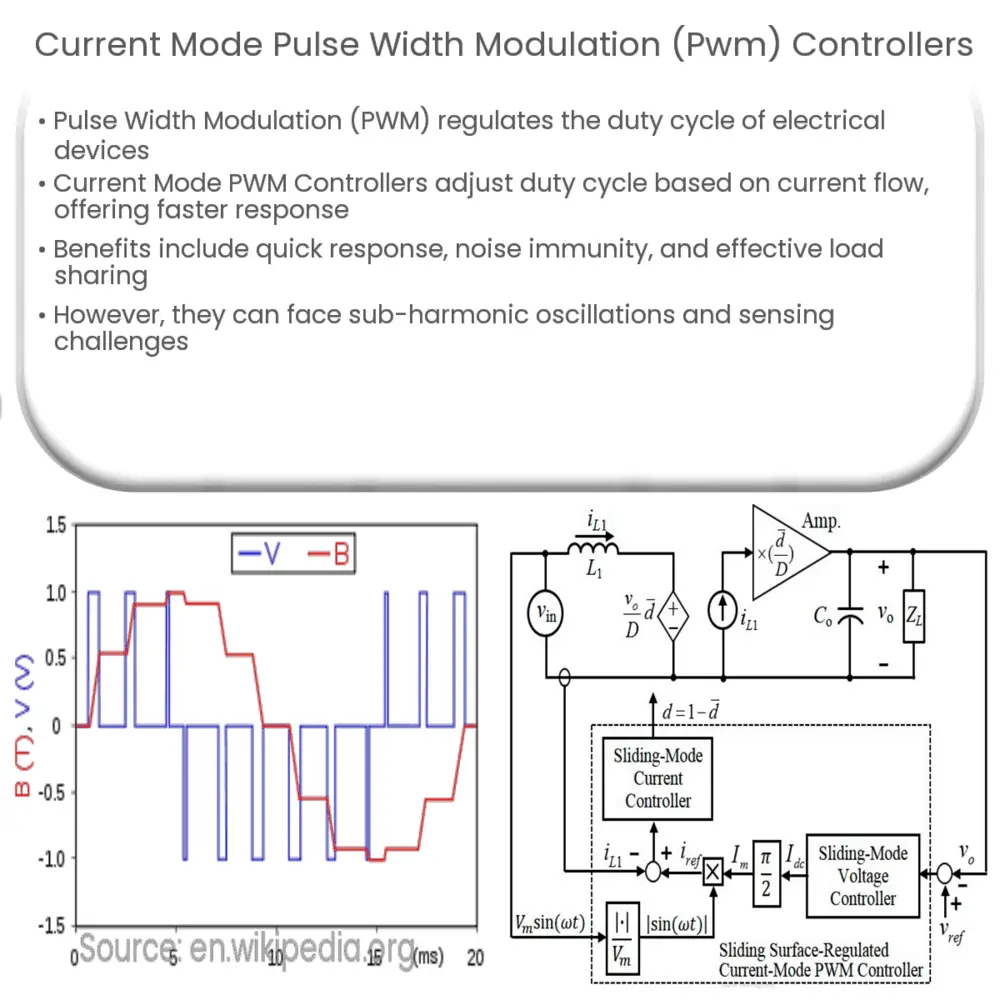Explore Current Mode PWM Controllers, their working principles, benefits, limitations, and applications. Dive into power electronics control mechanisms.

Introduction to Current Mode Pulse Width Modulation (PWM) Controllers
Pulse Width Modulation (PWM) is a highly effective method used in various domains, particularly in controlling the power supplied to electrical devices. The core idea is to regulate the duty cycle, altering the period for which a signal is high (‘on’) or low (‘off’). PWM controllers have extensive applications in areas like telecommunications, power electronics, and audio amplification. However, the focus of this discussion will be on a specific type of PWM controller – the Current Mode PWM Controller.
Working Principle of PWM Controllers
A PWM controller works by creating a square wave signal, the ‘on’ and ‘off’ periods of which can be modulated. The ‘duty cycle’ represents the proportion of the ‘on’ time to the total period of the wave. In a voltage mode PWM controller, the duty cycle gets modified in response to changes in input voltage. However, in a current mode controller, the current flowing through the device informs changes to the duty cycle.
Understanding Current Mode PWM Controllers
In a Current Mode PWM Controller, the duty cycle is directly controlled by the current flowing through the circuit or device. This controller type senses the current and adjusts the PWM duty cycle accordingly, offering a faster response time. Hence, it is a popular choice for applications that need quick adjustments and a higher degree of control precision.
Advantages of Current Mode PWM Controllers
-
Fast Response: Due to the inherent characteristic of current mode control, the response time to changes is typically quicker than that of a voltage mode controller. This is a significant advantage in systems requiring rapid adjustments to maintain stability.
-
Improved Noise Immunity: Current mode PWM controllers offer better immunity to input voltage noise, an attribute particularly beneficial in power-sensitive applications.
-
Effective Load Sharing: If you’re working with multiple power supply units (PSUs), current mode control allows for easier and more effective load sharing.
Despite these advantages, understanding the limitations of Current Mode PWM Controllers is just as important for their effective implementation. To discuss these limitations and delve deeper into the applications of these controllers, we will continue in the next section.
Limitations of Current Mode PWM Controllers
Like any technology, Current Mode PWM Controllers come with their set of limitations. Recognizing these can help engineers and designers choose the right controller for their specific application.
-
Sub-Harmonic Oscillations: In applications with a duty cycle greater than 0.5, Current Mode PWM Controllers can experience sub-harmonic oscillations, leading to stability issues. However, this problem can be mitigated using slope compensation techniques.
-
Current Sensing Challenges: Accurate current sensing is key for Current Mode PWM Controllers to function optimally. Any inaccuracies can lead to suboptimal performance. Moreover, the method of current sensing can add complexity to the circuit design.
-
Increased Complexity: Current Mode PWM Controllers are inherently more complex than their voltage mode counterparts. This complexity can make them more challenging to design and implement, particularly in high-performance applications.
Applications of Current Mode PWM Controllers
Despite these limitations, Current Mode PWM Controllers find use in a wide range of applications where rapid response time and improved noise immunity are paramount. They are commonly employed in power supplies, DC-DC converters, telecommunication equipment, and more. For instance, they are extensively used in switch-mode power supplies (SMPS), where they help regulate the output voltage despite changes in input voltage or output load.
Conclusion
To sum up, Current Mode PWM Controllers provide an efficient way of controlling the power delivered to electrical devices. While they have certain limitations, their benefits often outweigh these drawbacks, especially in applications demanding fast response times and robust noise immunity. Understanding the working principles, advantages, limitations, and applications of these controllers can aid designers in choosing the right control mechanism for their specific needs. The technological landscape continues to evolve, and with it, the sophistication and capabilities of control mechanisms like Current Mode PWM Controllers. Embracing this understanding can lead to more efficient, reliable, and versatile power electronic systems.

